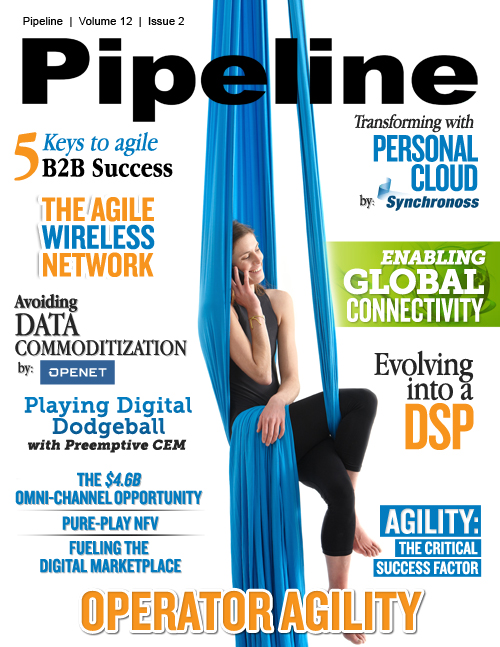5 Keys to an Agile Transformation for Success in B2B
Traditional solutions to this dilemma are time consuming and expensive; a CSP can’t “rip-and-replace” or engage in a system consolidation project without losing valuable time in the marketplace. In order to rapidly serve the business customer, CSPs must connect and unify these tech enclaves and drive toward applications that can start quickly and scale from there. Establish a command and control layer able to consistently interact with the customers and select priority sales and fulfillment processes such as CPQ(Configure, Price, Quote) or O2A(Order to Activate) for process improvement. This command and control layer can work with existing systems of record allowing for quicker deployments.
The velocity that can be achieved is compelling. Telstra, for example, sought to dramatically reduce response time for new telephony customers and streamline IP activation across the service chain. By implementing a solution from Pegasystems, Telstra went “from 70 to 80 days to provide a service to a business-to-business transaction...down to 8 or 9 days,” said Peter McDonald, general manager of process excellence at Telstra.
3. Make change a strategic advantage
If anything is true in technology, it is that change occurs faster each year. Businesses seek systems and processes that enable them to pivot in response to customer demand and market conditions, or even better, sense opportunities and adjust course accordingly. Catalog-driven sales and systems offer a major advantage, in terms of agility. In order to compete in the digital economy, CSPs must essentially become digital-services retailers of hundreds, if not thousands, of product and product variations. They must be able to rapidly design, sell, launch, and scale solutions, integrate their offerings seamlessly with third-party solutions and numerous partners, and constantly manage dynamic promotions and incentive bundling to stay ahead of competitors and meet the needs of an increasingly demanding user base.
Most CSPs are aware of the benefits of a catalog-driven approach, but the concept should be widened to reflect the new ecosystems that CSPs are building. For example, CSPs are differentiating with multiple external cloud partners for services such as CRM, storage, collaboration, backup, and more. Service providers require a catalog and sales strategy that accommodates the entire ecosystem, not just in-house services. Such a catalog can easily add external offerings as they become available, or desirable. Likewise, a unified sales process is required that treats all services the same, whether they originate internally or from a partner.
Telecom Italia, for example, embarked on an initiative to unify its catalog for service bundles. Previously, the many services existed in disparate silos based on domain technology. Recognizing its customers’ need for agility, Telecom Italia set about to build a “dynamic opportunity platform, able to follow the changing decisions of our main customers,” said the head of customer management and relations at TeIecom Italia at a PegaWORLD event. By implementing a unified catalog, the company reduced its new product launch time from months to days.
The ability to make changes to systems and process without involvement from IT is an agility booster as well. Many systems require long hours of coding, many cycles of approvals, and simply a lot of time to implement small changes to a service, like new group permissions for a VPN. "Vodafone Germany recognized this need, said Jens Fudickar. "It responded by implementing a new platform so that “business for themselves, without IT, have the possibility to do changes,” offering the companies “much more flexibility than they have now.”
4. Put customer interests first
When you consider your services portfolio, which comes first: the customer or the product? In the past, service providers built buckets and bundles into which customers were expected to fit. This just doesn’t make sense, and will become even more irrelevant as M2M and IoT opportunities take shape. Service offerings should be as unique and customizable as each business that is served, and this requires a customer-first philosophy and creativity. In fact, in the Vanson Bourne study cited above, IT buyers listed creativity as the second most important characteristic next to quality when evaluating proposals.
If a smaller customer wants VPN, 5 mobile lines, cloud backup from a partner, and asset tracking for high value cargo, the answer should be: no problem. If an enterprise customer wants global unified collaboration, cloud storage in Germany, and 2,000 local numbers in London, plus a mobile femtocell and a connected car offering for the CEO, the answer should be the same. The service providers who will succeed in the future will get very creative with the services they offer, and their sales and CPQ processes will be fine-tuned to offer user-defined products and custom bundles.
5. Create repeatability and reuse within systems
As CSPs transform to meet the dynamic needs of the business customer, some processes and products will rise to the top as gold standards. Service providers should leverage the inherent value of these discoveries, and develop a common process layer from which to build levels of change. This is especially true as new geographies and industry verticals come into play. Again, agility is key, and what a CSP learns from successfully deploying, say, IoT for healthcare, can serve as a tweakable roadmap as the company deploys IoT for municipalities and connected cities.
This strategy also works well for network virtualization applications. Service providers are deploying SDN and NFV in limited domains, like storage and backup, with plans to extend the technology into other areas, such as evolved packet core (EPC) or virtual customer premise equipment (vCPE). It also applies to regional processes, trial markets, and net new service trials.



















